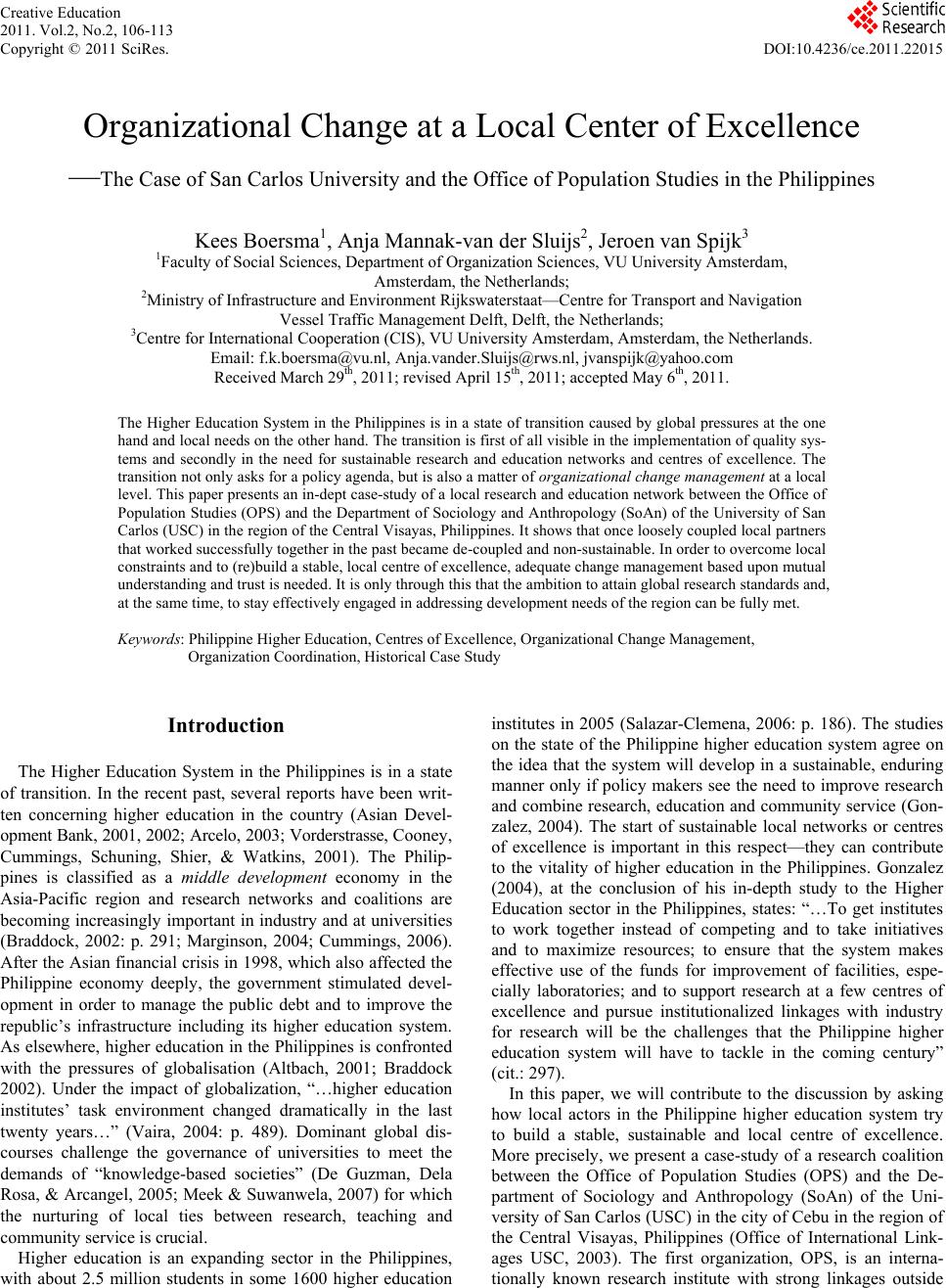 Creative Education 2011. Vol.2, No.2, 106-113 Copyright © 2011 SciRes. DOI:10.4236/ce.2011.22015 Organizational Change at a Local Center of Excellence —The Case of San Carlos University and the Office of Population Studies in the Philippines Kees Boersma1, Anja Mannak-van der Sluijs2, Jeroen van Spijk3 1Faculty of Social Sciences, Department of Organization Sciences, VU University Amsterdam, Amsterdam, the Netherlands; 2Ministry of Infrastructure and Environment Rijkswaterstaat—Centre for Transport and Navigation Vessel Traffic Management Delft, Delft, the Netherlands; 3Centre for International Cooperation (CIS), VU University Amsterdam, Amsterdam, the Netherlands. Email: f.k.boersma@vu.nl, Anja.vander.Sluijs@rws.nl, jvanspijk@yahoo.com Received March 29th, 2011; revised April 15th, 2011; accepted May 6th, 2011. The Higher Education System in the Philippines is in a state of transition caused by global pressures at the one hand and local needs on the other hand. The transition is first of all visible in the implementation of quality sys- tems and secondly in the need for sustainable research and education networks and centres of excellence. The transition not only asks for a policy agenda, but is also a matter of organizational change management at a local level. This paper presents an in-dept case-study of a local research and education network between the Office of Population Studies (OPS) and the Department of Sociology and Anthropology (SoAn) of the University of San Carlos (USC) in the region of the Central Visayas, Philippines. It shows that once loosely coupled local partners that worked successfully together in the past became de-coupled and non-sustainable. In order to overcome local constraints and to (re)build a stable, local centre of excellence, adequate change management based upon mutual understanding and trust is needed. It is only through this that the ambition to attain global research standards and, at the same time, to stay effectively engaged in addressing developm e nt n ee ds of t he region can be fully met. Keywords: Philippine Higher Education, Centres of Excellence, Organizational Change Management, Organization Coordinatio n , Historical Case Study Introduction The Higher Education System in the Philippines is in a state of transition. In the recent past, several reports have been writ- ten concerning higher education in the country (Asian Devel- opment Bank, 2001, 2002; Arcelo, 2003; Vorderstrasse, Cooney, Cummings, Schuning, Shier, & Watkins, 2001). The Philip- pines is classified as a middle development economy in the Asia-Pacific region and research networks and coalitions are becoming increasingly important in industry and at universities (Braddock, 2002: p. 291; Marginson, 2004; Cummings, 2006). After the Asian financial crisis in 1998, which also affected the Philippine economy deeply, the government stimulated devel- opment in order to manage the public debt and to improve the republic’s infrastructure including its higher education system. As elsewhere, higher education in the Philippines is confronted with the pressures of globalisation (Altbach, 2001; Braddock 2002). Under the impact of globalization, “…higher education institutes’ task environment changed dramatically in the last twenty years…” (Vaira, 2004: p. 489). Dominant global dis- courses challenge the governance of universities to meet the demands of “knowledge-based societies” (De Guzman, Dela Rosa, & Arcangel, 2005; Meek & Suwanwela, 2007) for which the nurturing of local ties between research, teaching and community service is crucial. Higher education is an expanding sector in the Philippines, with about 2.5 million students in some 1600 higher education institutes in 2005 (Salazar-Clemena, 2006: p. 186). The studies on the state of the Philippine higher education system agree on the idea that the system will develop in a sustainable, enduring manner only if policy makers see the need to improve research and combine research, education and community service (Gon- zalez, 2004). The start of sustainable local networks or centres of excellence is important in this respect—they can contribute to the vitality of higher education in the Philippines. Gonzalez (2004), at the conclusion of his in-depth study to the Higher Education sector in the Philippines, states: “…To get institutes to work together instead of competing and to take initiatives and to maximize resources; to ensure that the system makes effective use of the funds for improvement of facilities, espe- cially laboratories; and to support research at a few centres of excellence and pursue institutionalized linkages with industry for research will be the challenges that the Philippine higher education system will have to tackle in the coming century” (cit.: 297). In this paper, we will contribute to the discussion by asking how local actors in the Philippine higher education system try to build a stable, sustainable and local centre of excellence. More precisely, we present a case-study of a research coalition between the Office of Population Studies (OPS) and the De- partment of Sociology and Anthropology (SoAn) of the Uni- versity of San Carlos (USC) in the city of Cebu in the region of the Central Visayas, Philippines (Office of International Link- ages USC, 2003). The first organization, OPS, is an interna- tionally known research institute with strong linkages outside 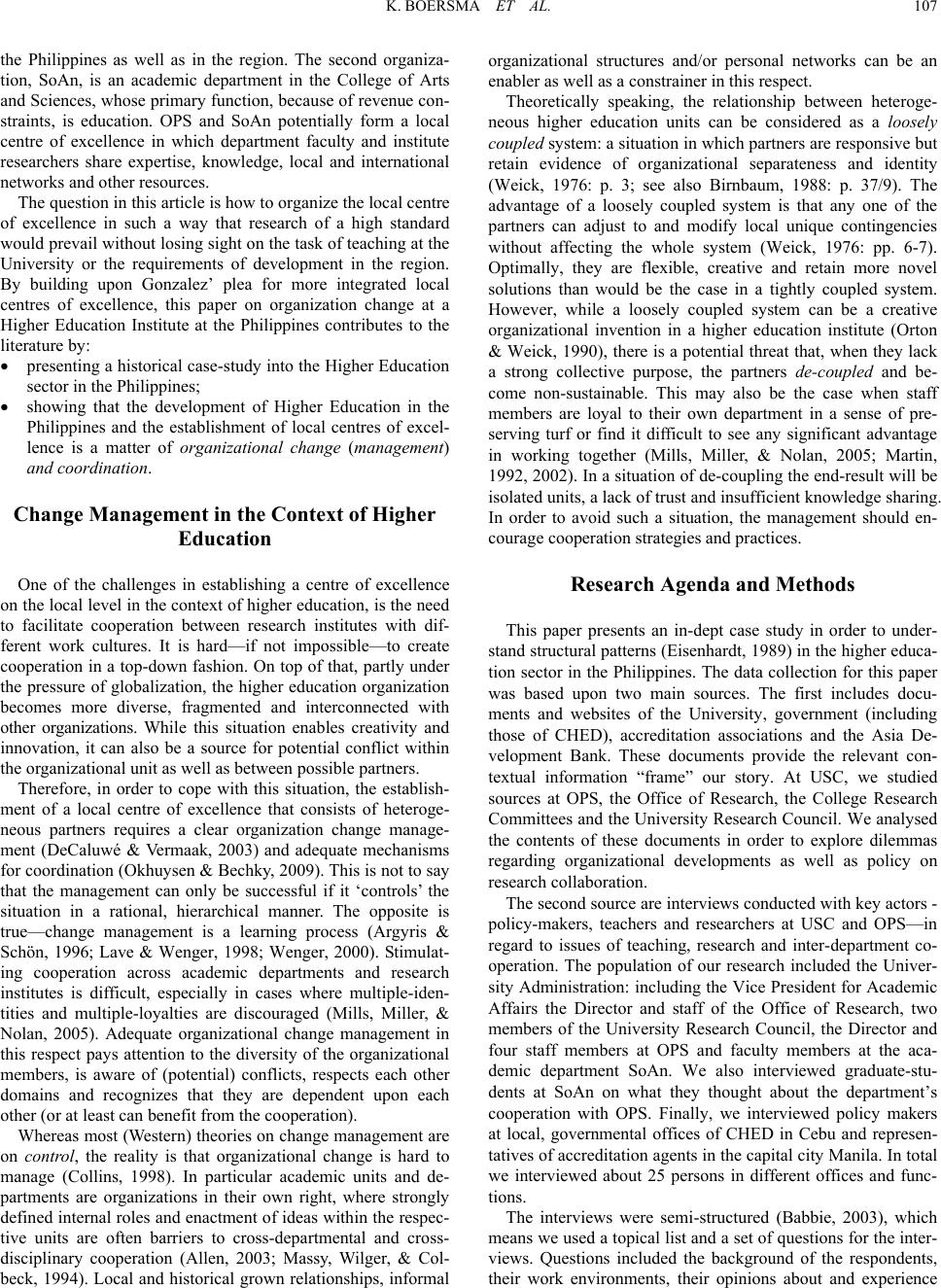 K. BOERSMA ET AL. 107 the Philippines as well as in the region. The second organiza- tion, SoAn, is an academic department in the College of Arts and Sciences, whose primary function, because of revenue con- straints, is education. OPS and SoAn potentially form a local centre of excellence in which department faculty and institute researchers share expertise, knowledge, local and international networks and other resources. The question in this article is how to organize the local centre of excellence in such a way that research of a high standard would prevail without losing sight on the task of teaching at the University or the requirements of development in the region. By building upon Gonzalez’ plea for more integrated local centres of excellence, this paper on organization change at a Higher Education Institute at the Philippines contributes to the literature by: presenting a historical case-study into the Higher Education sector in the Philippines; showing that the development of Higher Education in the Philippines and the establishment of local centres of excel- lence is a matter of organizational change (management) and coordination. Change Management in the Context of Higher Education One of the challenges in establishing a centre of excellence on the local level in the context of higher education, is the need to facilitate cooperation between research institutes with dif- ferent work cultures. It is hard—if not impossible—to create cooperation in a top-down fashion. On top of that, partly under the pressure of globalization, the higher education organization becomes more diverse, fragmented and interconnected with other organizations. While this situation enables creativity and innovation, it can also be a source for potential conflict within the organizational unit as well as between possible partners. Therefore, in order to cope with this situation, the establish- ment of a local centre of excellence that consists of heteroge- neous partners requires a clear organization change manage- ment (DeCaluwé & Vermaak, 2003) and adequate mechanisms for coordination (Okhuysen & Bechky, 2009). This is not to say that the management can only be successful if it ‘controls’ the situation in a rational, hierarchical manner. The opposite is true—change management is a learning process (Argyris & Schön, 1996; Lave & Wenger, 1998; Wenger, 2000). Stimulat- ing cooperation across academic departments and research institutes is difficult, especially in cases where multiple-iden- tities and multiple-loyalties are discouraged (Mills, Miller, & Nolan, 2005). Adequate organizational change management in this respect pays attention to the diversity of the organizational members, is aware of (potential) conflicts, respects each other domains and recognizes that they are dependent upon each other (or at least can benefit from the cooperation). Whereas most (Western) theories on change management are on control, the reality is that organizational change is hard to manage (Collins, 1998). In particular academic units and de- partments are organizations in their own right, where strongly defined internal roles and enactment of ideas within the respec- tive units are often barriers to cross-departmental and cross- disciplinary cooperation (Allen, 2003; Massy, Wilger, & Col- beck, 1994). Local and historical grown relationships, informal organizational structures and/or personal networks can be an enabler as well as a constrainer in this respect. Theoretically speaking, the relationship between heteroge- neous higher education units can be considered as a loosely coupled system: a situation in which partners are responsive but retain evidence of organizational separateness and identity (Weick, 1976: p. 3; see also Birnbaum, 1988: p. 37/9). The advantage of a loosely coupled system is that any one of the partners can adjust to and modify local unique contingencies without affecting the whole system (Weick, 1976: pp. 6-7). Optimally, they are flexible, creative and retain more novel solutions than would be the case in a tightly coupled system. However, while a loosely coupled system can be a creative organizational invention in a higher education institute (Orton & Weick, 1990), there is a potential threat that, when they lack a strong collective purpose, the partners de-coup led and be- come non-sustainable. This may also be the case when staff members are loyal to their own department in a sense of pre- serving turf or find it difficult to see any significant advantage in working together (Mills, Miller, & Nolan, 2005; Martin, 1992, 2002). In a situation of de-coupling the end-result will be isolated units, a lack of trust and insufficient knowledge sharing. In order to avoid such a situation, the management should en- courage cooperation strategies and practices. Research Agenda and Methods This paper presents an in-dept case study in order to under- stand structural patterns (Eisenhardt, 1989) in the higher educa- tion sector in the Philippines. The data collection for this paper was based upon two main sources. The first includes docu- ments and websites of the University, government (including those of CHED), accreditation associations and the Asia De- velopment Bank. These documents provide the relevant con- textual information “frame” our story. At USC, we studied sources at OPS, the Office of Research, the College Research Committees and the University Research Council. We analysed the contents of these documents in order to explore dilemmas regarding organizational developments as well as policy on research collaboration. The second source are interviews conducted with key actors - policy-makers, teachers and researchers at USC and OPS—in regard to issues of teaching, research and inter-department co- operation. The population of our research included the Univer- sity Administration: including the Vice President for Academic Affairs the Director and staff of the Office of Research, two members of the University Research Council, the Director and four staff members at OPS and faculty members at the aca- demic department SoAn. We also interviewed graduate-stu- dents at SoAn on what they thought about the department’s cooperation with OPS. Finally, we interviewed policy makers at local, governmental offices of CHED in Cebu and represen- tatives of accreditation agents in the capital city Manila. In total we interviewed about 25 persons in different offices and func- tions. The interviews were semi-structured (Babbie, 2003), which means we used a topical list and a set of questions for the inter- views. Questions included the background of the respondents, their work environments, their opinions about and experience 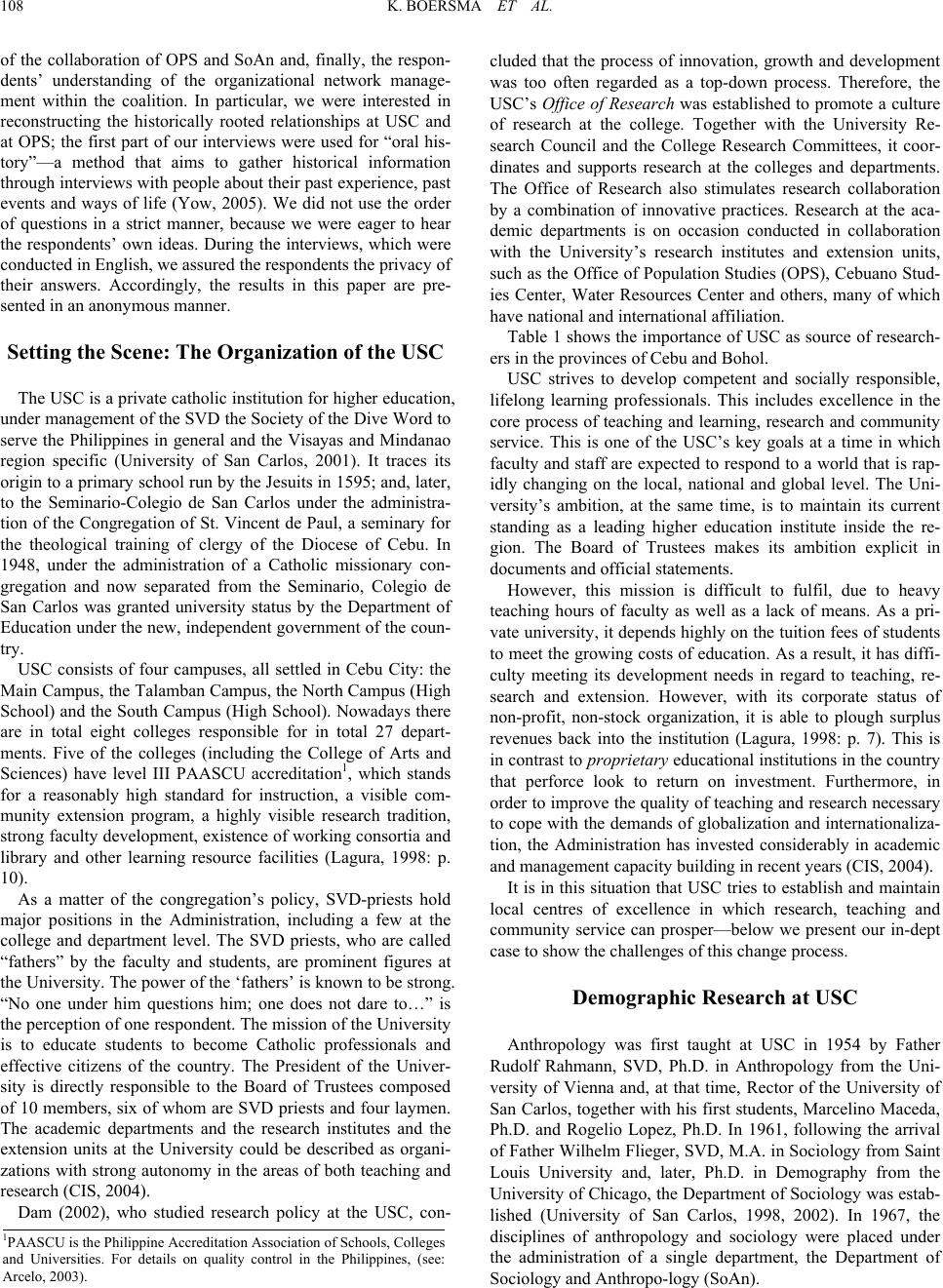 K. BOERSMA ET AL. 108 of the collaboration of OPS and SoAn and, finally, the respon- dents’ understanding of the organizational network manage- ment within the coalition. In particular, we were interested in reconstructing the historically rooted relationships at USC and at OPS; the first part of our interviews were used for “oral his- tory”—a method that aims to gather historical information through interviews with people about their past experience, past events and ways of life (Yow, 2005). We did not use the order of questions in a strict manner, because we were eager to hear the respondents’ own ideas. During the interviews, which were conducted in English, we assured the respondents the privacy of their answers. Accordingly, the results in this paper are pre- sented in an anonymous manner. Setting the Scene: The Organization of the USC The USC is a private catholic institution for higher education, under management of the SVD the Society of the Dive Word to serve the Philippines in general and the Visayas and Mindanao region specific (University of San Carlos, 2001). It traces its origin to a primary school run by the Jesuits in 1595; and, later, to the Seminario-Colegio de San Carlos under the administra- tion of the Congregation of St. Vincent de Paul, a seminary for the theological training of clergy of the Diocese of Cebu. In 1948, under the administration of a Catholic missionary con- gregation and now separated from the Seminario, Colegio de San Carlos was granted university status by the Department of Education under the new, independent government of the coun- try. USC consists of four campuses, all settled in Cebu City: the Main Campus, the Ta lamba n Campus, the North Campus (High School) and the South Campus (High School). Nowadays there are in total eight colleges responsible for in total 27 depart- ments. Five of the colleges (including the College of Arts and Sciences) have level III PAASCU accreditation1, which stands for a reasonably high standard for instruction, a visible com- munity extension program, a highly visible research tradition, strong faculty development, existence of working consortia and library and other learning resource facilities (Lagura, 1998: p. 10). As a matter of the congregation’s policy, SVD-priests hold major positions in the Administration, including a few at the college and department level. The SVD priests, who are called “fathers” by the faculty and students, are prominent figures at the University. The power of the ‘fathers’ is known to be strong. “No one under him questions him; one does not dare to…” is the perception of one respondent. The mission of the University is to educate students to become Catholic professionals and effective citizens of the country. The President of the Univer- sity is directly responsible to the Board of Trustees composed of 10 members, six of whom are SVD priests and four laymen. The academic departments and the research institutes and the extension units at the University could be described as organi- zations with strong autonomy in the areas of both teaching and research (CIS, 2004). Dam (2002), who studied research policy at the USC, con- cluded that the process of innovation, growth and development was too often regarded as a top-down process. Therefore, the USC’s Office of Research was established to promote a culture of research at the college. Together with the University Re- search Council and the College Research Committees, it coor- dinates and supports research at the colleges and departments. The Office of Research also stimulates research collaboration by a combination of innovative practices. Research at the aca- demic departments is on occasion conducted in collaboration with the University’s research institutes and extension units, such as the Office of Population Studies (OPS), Cebuano Stud- ies Center, Water Resources Center and others, many of which have national and international affiliation. Table 1 shows the importance of USC as source of research- ers in the provinces of Cebu and Bohol. USC strives to develop competent and socially responsible, lifelong learning professionals. This includes excellence in the core process of teaching and learning, research and community service. This is one of the USC’s key goals at a time in which faculty and staff are expected to respond to a world that is rap- idly changing on the local, national and global level. The Uni- versity’s ambition, at the same time, is to maintain its current standing as a leading higher education institute inside the re- gion. The Board of Trustees makes its ambition explicit in documents and official statements. However, this mission is difficult to fulfil, due to heavy teaching hours of faculty as well as a lack of means. As a pri- vate university, it depends highly on the tuition fees of students to meet the growing costs of education. As a result, it has diffi- culty meeting its development needs in regard to teaching, re- search and extension. However, with its corporate status of non-profit, non-stock organization, it is able to plough surplus revenues back into the institution (Lagura, 1998: p. 7). This is in contrast to proprietary educational institutions in the country that perforce look to return on investment. Furthermore, in order to improve the quality of teaching and research necessary to cope with the demands of globalization and internationaliza- tion, the Administration has invested considerably in academic and management capacity building in recent years (CIS, 2004). It is in this situation that USC tries to establish and maintain local centres of excellence in which research, teaching and community service can prosper—below we present our in-dept case to show the challenges of this change process. Demographic Research at USC Anthropology was first taught at USC in 1954 by Father Rudolf Rahmann, SVD, Ph.D. in Anthropology from the Uni- versity of Vienna and, at that time, Rector of the University of San Carlos, together with his first students, Marcelino Maceda, Ph.D. and Rogelio Lopez, Ph.D. In 1961, following the arrival of Father Wilhelm Flieger, SVD, M.A. in Sociology from Saint Louis University and, later, Ph.D. in Demography from the Universi ty of Chica go, the Depart ment of Soc iology was est ab- lished (University of San Carlos, 1998, 2002). In 1967, the disciplines of anthropology and sociology were placed under the administration of a single department, the Department of ociology and Anthropo-logy (SoAn). 1PAASCU is the Philippine Accreditation Association of Schools, Colleges and Universities. For details on quality control in the Philippines, (see: Arcelo, 2003). S 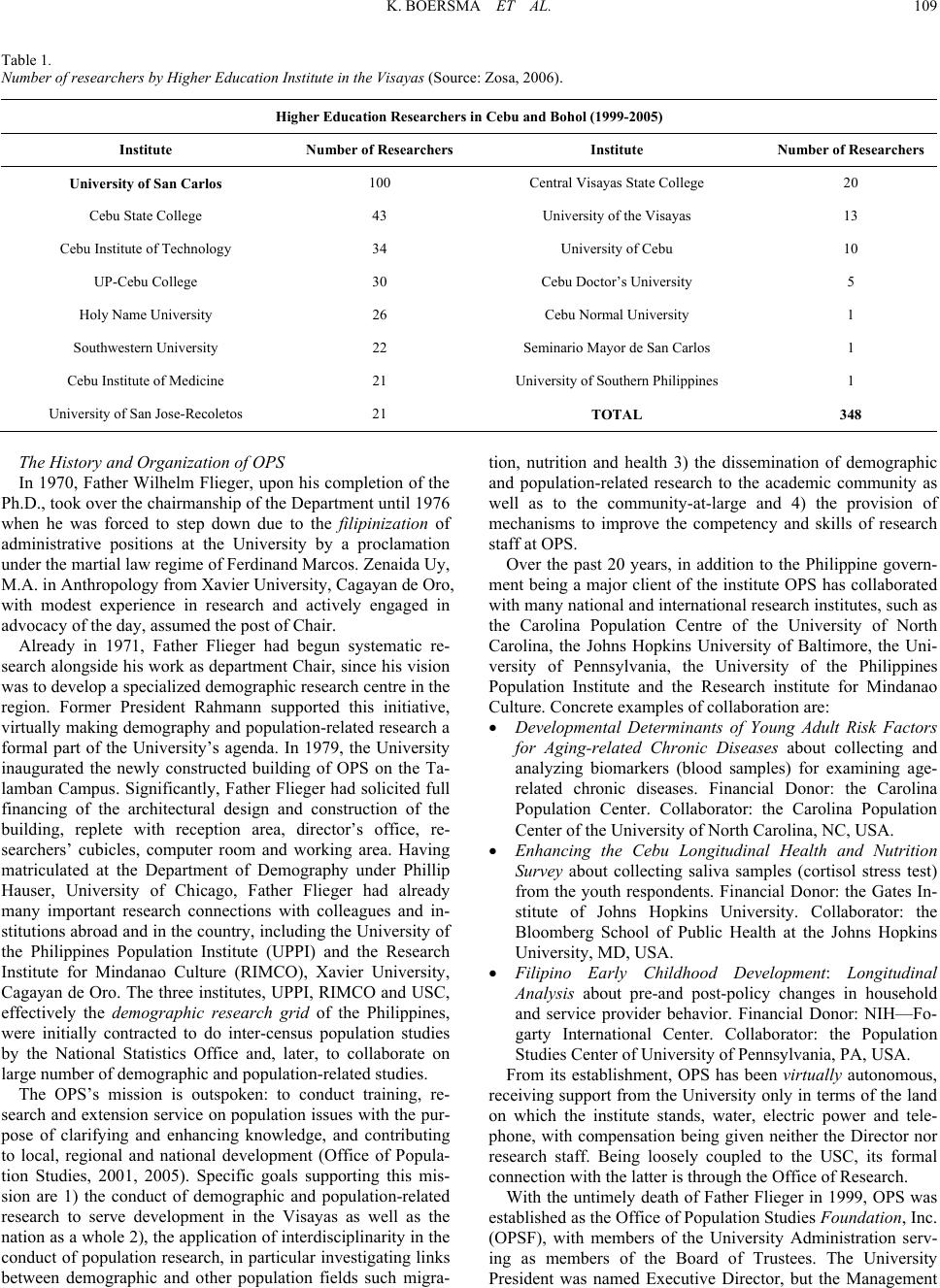 K. BOERSMA ET AL. 109 Table 1. Number of researchers by Higher Education Institute in the Visayas (Source: Zosa, 2006) . Higher Education Researchers in Cebu and Bohol (1999-2005) Institute Number of Researchers Institute Number of Researchers University of San Carlos 100 Central Vi s ayas State College 20 Cebu State College 43 University of t h e Visayas 13 Cebu Institute of Tec hn ology 34 University o f Cebu 10 UP-Cebu College 30 Cebu Doctor’ s University 5 Holy Name University 26 Cebu Norm al University 1 Southwestern Univers ity 22 Seminario Mayor de San Carlos 1 Cebu Institute of Medicine 21 University of Southern Philippines 1 University of San Jose-Recoletos 21 TOTAL 348 The History and Organization of OPS In 1970, Father Wilhelm Flieger, upon his completion of the Ph.D., took over the chairmanship of the Department until 1976 when he was forced to step down due to the filipinization of administrative positions at the University by a proclamation under the martial law regime of Ferdinand Marcos. Zenaida Uy, M.A. in Anthropology from Xavier University, Cagayan de Oro, with modest experience in research and actively engaged in advocacy of the day, assumed the post of Chair. Already in 1971, Father Flieger had begun systematic re- search alongside his work as department Chair, since his vision was to develop a specialized demographic research centre in the region. Former President Rahmann supported this initiative, virtually making demography and population-related research a formal part of the University’s agenda. In 1979, the University inaugurated the newly constructed building of OPS on the Ta- lamban Campus. Significantly, Father Flieger had solicited full financing of the architectural design and construction of the building, replete with reception area, director’s office, re- searchers’ cubicles, computer room and working area. Having matriculated at the Department of Demography under Phillip Hauser, University of Chicago, Father Flieger had already many important research connections with colleagues and in- stitutions abroad and in the country, including the University of the Philippines Population Institute (UPPI) and the Research Institute for Mindanao Culture (RIMCO), Xavier University, Cagayan de Oro. The three institutes, UPPI, RIMCO and USC, effectively the demographic research grid of the Philippines, were initially contracted to do inter-census population studies by the National Statistics Office and, later, to collaborate on large number of demographic and population-related studies. The OPS’s mission is outspoken: to conduct training, re- search and extension service on population issues with the pur- pose of clarifying and enhancing knowledge, and contributing to local, regional and national development (Office of Popula- tion Studies, 2001, 2005). Specific goals supporting this mis- sion are 1) the conduct of demographic and population-related research to serve development in the Visayas as well as the nation as a whole 2), the application of interdisciplinarity in the conduct of population research, in particular investigating links between demographic and other population fields such migra- tion, nutrition and health 3) the dissemination of demographic and population-related research to the academic community as well as to the community-at-large and 4) the provision of mechanisms to improve the competency and skills of research staff at OPS. Over the past 20 years, in addition to the Philippine govern- ment being a major client of the institute OPS has collaborated with many national and international research institutes, such as the Carolina Population Centre of the University of North Carolina, the Johns Hopkins University of Baltimore, the Uni- versity of Pennsylvania, the University of the Philippines Population Institute and the Research institute for Mindanao Culture. Concrete examples of collaboration are: Developmental Determinants of Young Adult Risk Factors for Aging-related Chronic Diseases about collecting and analyzing biomarkers (blood samples) for examining age- related chronic diseases. Financial Donor: the Carolina Population Center. Collaborator: the Carolina Population Center of the University of North Carolina, NC, USA. Enhancing the Cebu Longitudinal Health and Nutrition Survey about collecting saliva samples (cortisol stress test) from the youth respondents. Financial Donor: the Gates In- stitute of Johns Hopkins University. Collaborator: the Bloomberg School of Public Health at the Johns Hopkins University, MD, USA. Filipino Early Childhood Development: Longitudinal Analysis about pre-and post-policy changes in household and service provider behavior. Financial Donor: NIH—Fo- garty International Center. Collaborator: the Population Studies Center of University of Pennsylvania, PA, USA. From its establishment, OPS has been virtually autonomous, receiving support from the University only in terms of the land on which the institute stands, water, electric power and tele- phone, with compensation being given neither the Director nor research staff. Being loosely coupled to the USC, its formal connection with the latter is through the Office of Research. With the untimely death of Father Flieger in 1999, OPS was established as the Office of Population Studies Foundation, Inc. (OPSF), with members of the University Administration serv- ing as members of the Board of Trustees. The University President was named Executive Director, but the Management 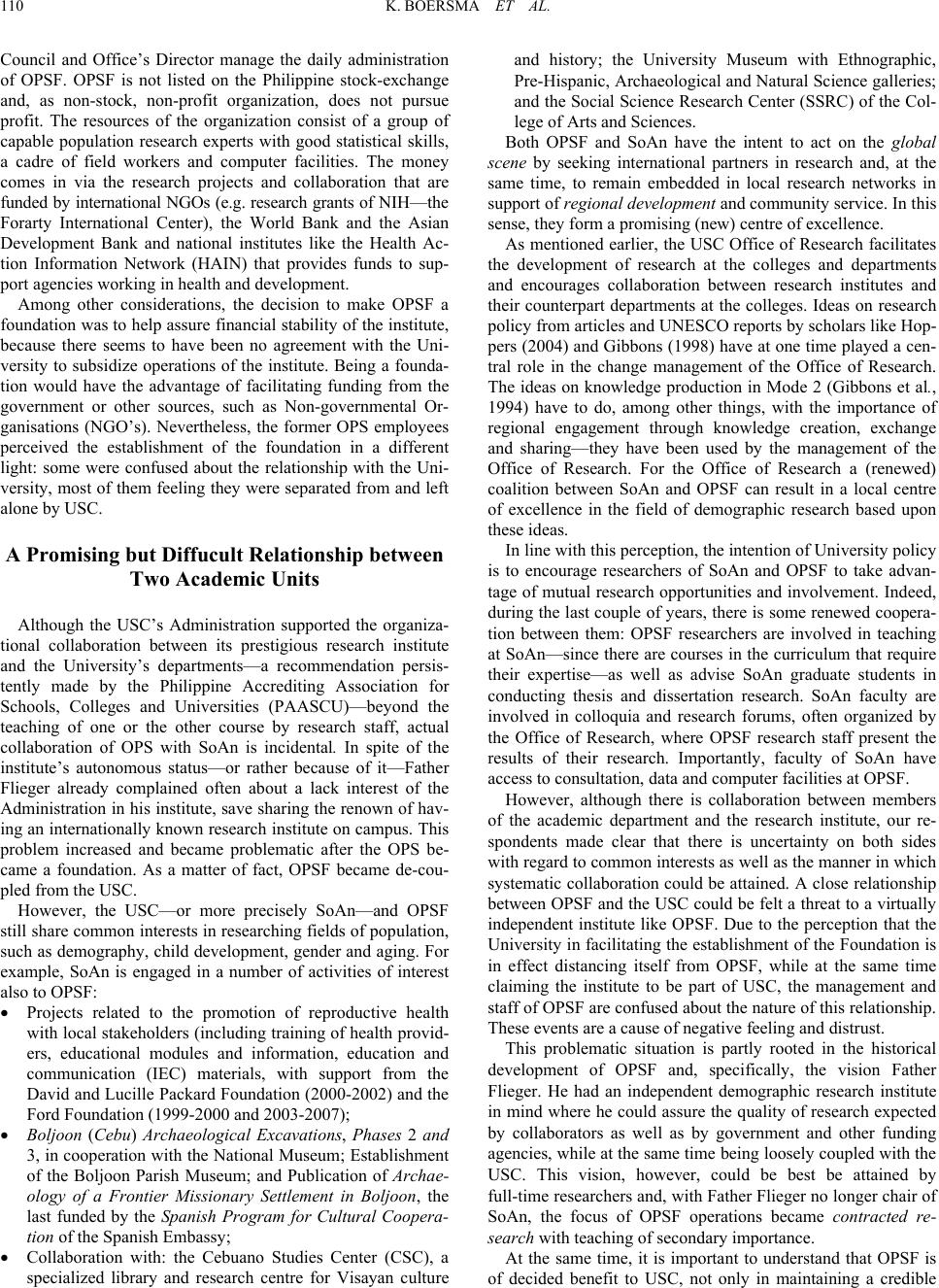 K. BOERSMA ET AL. 110 Council and Office’s Director manage the daily administration of OPSF. OPSF is not listed on the Philippine stock-exchange and, as non-stock, non-profit organization, does not pursue profit. The resources of the organization consist of a group of capable population research experts with good statistical skills, a cadre of field workers and computer facilities. The money comes in via the research projects and collaboration that are funded by international NGOs (e.g. research grants of NIH —the Forarty International Center), the World Bank and the Asian Development Bank and national institutes like the Health Ac- tion Information Network (HAIN) that provides funds to sup- port agencies working in health and development. Among other considerations, the decision to make OPSF a foundation was to help assure financial stability of the institute, because there seems to have been no agreement with the Uni- versity to subsidize operations of the institute. Being a founda- tion would have the advantage of facilitating funding from the government or other sources, such as Non-governmental Or- ganisations (NGO’s). Nevertheless, the former OPS employees perceived the establishment of the foundation in a different light: some were confused about the relationship with the Uni- versity, most of them feeling they were separated from and left alone by USC. A Promising but Diffucult Relationship between Two Academic Units Although the USC’s Administration supported the organiza- tional collaboration between its prestigious research institute and the University’s departments—a recommendation persis- tently made by the Philippine Accrediting Association for Schools, Colleges and Universities (PAASCU)—beyond the teaching of one or the other course by research staff, actual collaboration of OPS with SoAn is incidental. In spite of the institute’s autonomous status—or rather because of it—Father Flieger already complained often about a lack interest of the Administration in his institute, save sharing the renown of hav- ing an internationally known research institute on campus. This problem increased and became problematic after the OPS be- came a foundation. As a matter of fact, OPSF became de-cou- pled from the USC. However, the USC—or more precisely SoAn—and OPSF still share common interests in researching fields of population, such as demography, child development, gender and aging. For example, SoAn is engaged in a number of activities of interest also to OPSF: Projects related to the promotion of reproductive health with local stakeholders (including training of health provid- ers, educational modules and information, education and communication (IEC) materials, with support from the David and Lucille Packard Foundation (2000-2002) and the Ford Foundation (1999-2000 and 2003-2007); Boljoon (Cebu) Archaeological Excavations, Phases 2 and 3, in cooperation with the National Museum; Establishment of the Boljoon Parish Museum; and Publication of Archae- ology of a Frontier Missionary Settlement in Boljoon, the last funded by the Spanish Program for Cultural Coopera- tion of the Spanish Embassy; Collaboration with: the Cebuano Studies Center (CSC), a specialized library and research centre for Visayan culture and history; the University Museum with Ethnographic, Pre-Hispanic, Archaeological and Natural Science galleries; and the Social Science Research Center (SSRC) of the Col- lege of Arts and Sciences. Both OPSF and SoAn have the intent to act on the global scene by seeking international partners in research and, at the same time, to remain embedded in local research networks in support of regional development and community service. In this sense, they form a promising (new) centre of excellence. As mentioned earlier, the USC Office of Research facilitates the development of research at the colleges and departments and encourages collaboration between research institutes and their counterpart departments at the colleges. Ideas on research policy from articles and UNESCO reports by scholars like Hop- pers (2004) and Gibbons (1998) have at one time played a cen- tral role in the change management of the Office of Research. The ideas on knowledge production in Mode 2 (Gibbons et al., 1994) have to do, among other things, with the importance of regional engagement through knowledge creation, exchange and sharing—they have been used by the management of the Office of Research. For the Office of Research a (renewed) coalition between SoAn and OPSF can result in a local centre of excellence in the field of demographic research based upon these ideas. In line with this perception, the intention of University policy is to encourage researchers of SoAn and OPSF to take advan- tage of mutual research opportunities and involvement. Indeed, during the last couple of years, there is some renewed coopera- tion between them: OPSF researchers are involved in teaching at SoAn—since there are courses in the curriculum that require their expertise—as well as advise SoAn graduate students in conducting thesis and dissertation research. SoAn faculty are involved in colloquia and research forums, often organized by the Office of Research, where OPSF research staff present the results of their research. Importantly, faculty of SoAn have access to consultation, data a n d computer facilities at OPSF. However, although there is collaboration between members of the academic department and the research institute, our re- spondents made clear that there is uncertainty on both sides with regard to common interests as well as the manner in which systematic collaboration could be attained. A close relationship between OPSF and the USC could be felt a threat to a virtually independent institute like OPSF. Due to the perception that the University in facilitating the establishment of the Foundation is in effect distancing itself from OPSF, while at the same time claiming the institute to be part of USC, the management and staff of OPSF are confused about the nature of this relationship. These events are a cause of negative feeling and distrust. This problematic situation is partly rooted in the historical development of OPSF and, specifically, the vision Father Flieger. He had an independent demographic research institute in mind where he could assure the quality of research expected by collaborators as well as by government and other funding agencies, while at the same time being loosely coupled with the USC. This vision, however, could be best be attained by full-time researchers and, with Father Flieger no longer chair of SoAn, the focus of OPSF operations became contracted re- search with teaching of secondary importance. At the same time, it is important to understand that OPSF is of decided benefit to USC, not only in maintaining a credible 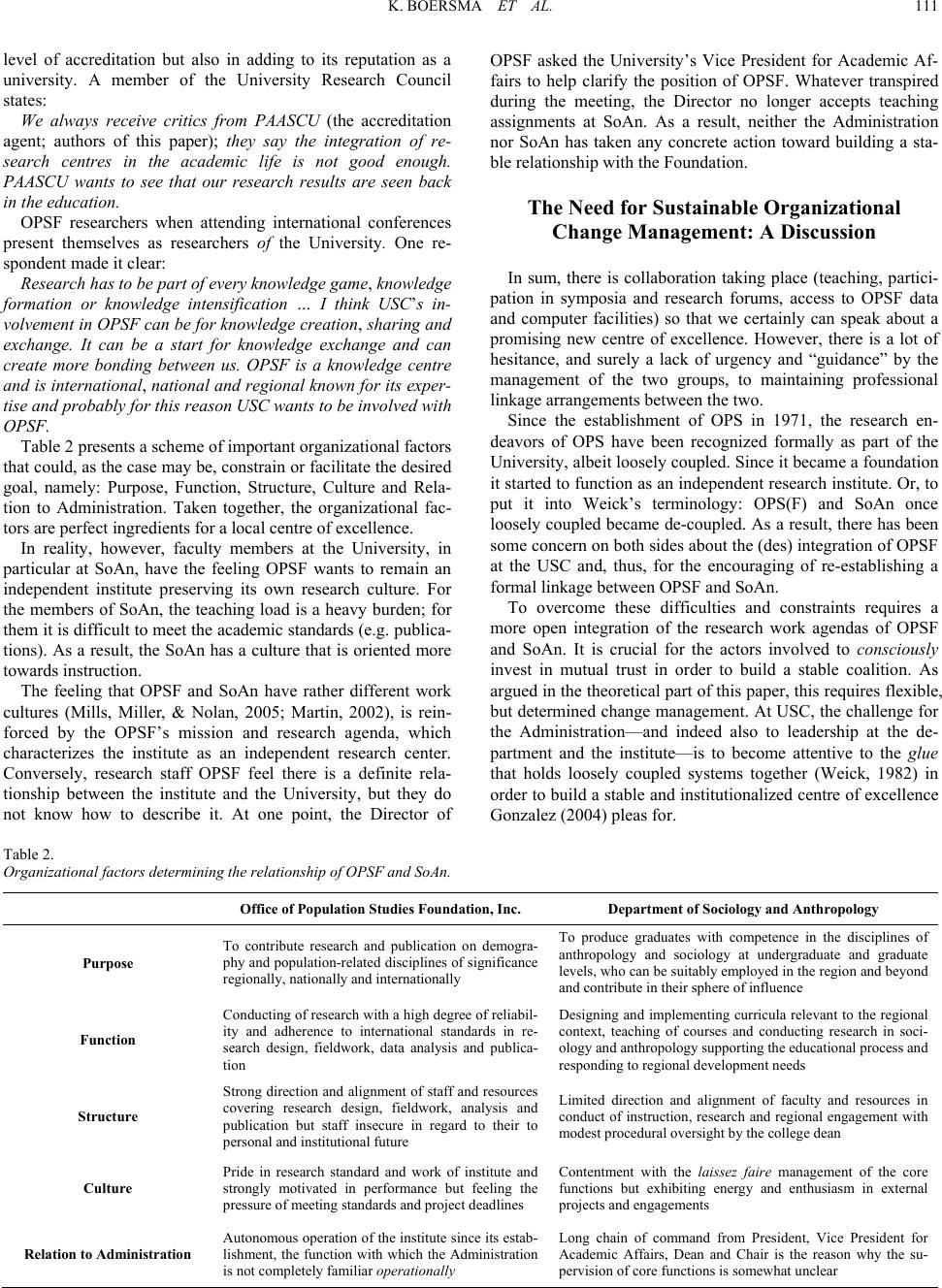 K. BOERSMA ET AL. 111 level of accreditation but also in adding to its reputation as a university. A member of the University Research Council states: We always receive critics from PAASCU (the accreditation agent; authors of this paper); they say the integration of re- search centres in the academic life is not good enough. PAASCU wants to see that our research results are seen back in the education. OPSF researchers when attending international conferences present themselves as researchers of the University. One re- spondent made it clear: Research has to be part of every knowledge game, knowledge formation or knowledge intensification … I think USC’s in- volvement in OPSF can be for knowledge creation, sharing and exchange. It can be a start for knowledge exchange and can create more bonding between us. OPSF is a knowledge centre and is international, national and regional known for its exper- tise and probably for this reason USC wants to be involved with OPSF. Table 2 presents a scheme of important organizational factors that could, as the case may be, constrain or facilitate the desired goal, namely: Purpose, Function, Structure, Culture and Rela- tion to Administration. Taken together, the organizational fac- tors are perfect ingredients for a local centre of excellence. In reality, however, faculty members at the University, in particular at SoAn, have the feeling OPSF wants to remain an independent institute preserving its own research culture. For the members of SoAn, the teaching load is a heavy burden; for them it is difficult to meet the academic standards (e.g. publica- tions). As a result, the SoAn has a culture that is oriented more towards instruction. The feeling that OPSF and SoAn have rather different work cultures (Mills, Miller, & Nolan, 2005; Martin, 2002), is rein- forced by the OPSF’s mission and research agenda, which characterizes the institute as an independent research center. Conversely, research staff OPSF feel there is a definite rela- tionship between the institute and the University, but they do not know how to describe it. At one point, the Director of OPSF asked the University’s Vice President for Academic Af- fairs to help clarify the position of OPSF. Whatever transpired during the meeting, the Director no longer accepts teaching assignments at SoAn. As a result, neither the Administration nor SoAn has taken any concrete action toward building a sta- ble relationship with the Foundation. The Need for Sustainable Organizational Change Management: A Discussion In sum, there is collaboration taking place (teaching, partici- pation in symposia and research forums, access to OPSF data and computer facilities) so that we certainly can speak about a promising new centre of excellence. However, there is a lot of hesitance, and surely a lack of urgency and “guidance” by the management of the two groups, to maintaining professional linkage arrangements between the two. Since the establishment of OPS in 1971, the research en- deavors of OPS have been recognized formally as part of the University, albeit loosely coupled. Since it became a foundation it started to function as an independent research institute. Or, to put it into Weick’s terminology: OPS(F) and SoAn once loosely coupled became de-coupled. As a result, there has been some concern on both sides about the (des) integration of OPSF at the USC and, thus, for the encouraging of re-establishing a formal linkage betwee n OPSF and SoAn. To overcome these difficulties and constraints requires a more open integration of the research work agendas of OPSF and SoAn. It is crucial for the actors involved to consciously invest in mutual trust in order to build a stable coalition. As argued in the theoretical part of this paper, this requires flexible, but determined change management. At USC, the challenge for the Administration—and indeed also to leadership at the de- partment and the institute—is to become attentive to the glue that holds loosely coupled systems together (Weick, 1982) in order to build a stable and institutionalized centre of excellence Gonzalez (2004) pleas for. Table 2. Organizational factors determining the r el at io n sh ip of O PSF and SoAn. Office of Population Studies Foundation, Inc. Department of Sociology and Anthropology Purpose To contribute research and publication on demogra- phy and population-related disciplines of significance regionally, nationally and internationally To produce graduates with competence in the disciplines of anthropology and sociology at undergraduate and graduate levels, who can be suitably employed in the region and beyond and contribute in their sphere of influenc e Function Conducting of research with a high degree of reliabil- ity and adherence to international standards in re- search design, fieldwork, data analysis and publica- tion Designing and implementing curricula relevant to the regional context, teaching of courses and conducting research in soci- ology and a nthropology s upporting the educat io nal process and responding to re gional deve lopment needs Structure Strong direction and alignment of staff and resources covering research design, fieldwork, analysis and publication but staff insecure in regard to their to personal and institutional future Limited direction and alignment of faculty and resources in conduct of instruction, research and regional engagement with modest proc edural oversight by th e college dean Culture Pride in research standard and work of institute and strongly motivated in performance but feeling the pressure of meeting standards and project deadlines Contentment with the laissez faire management of the core functions but exhibiting energy and enthusiasm in external projects and engagements Relation to Administration Autonomous operation of the institute since its estab- lishment, the function with which the Administration is not completely familiar operationally Long chain of command from President, Vice President for Academic Affairs, Dean and Chair is the reason why the su- pervision of core functions is somewhat unclear 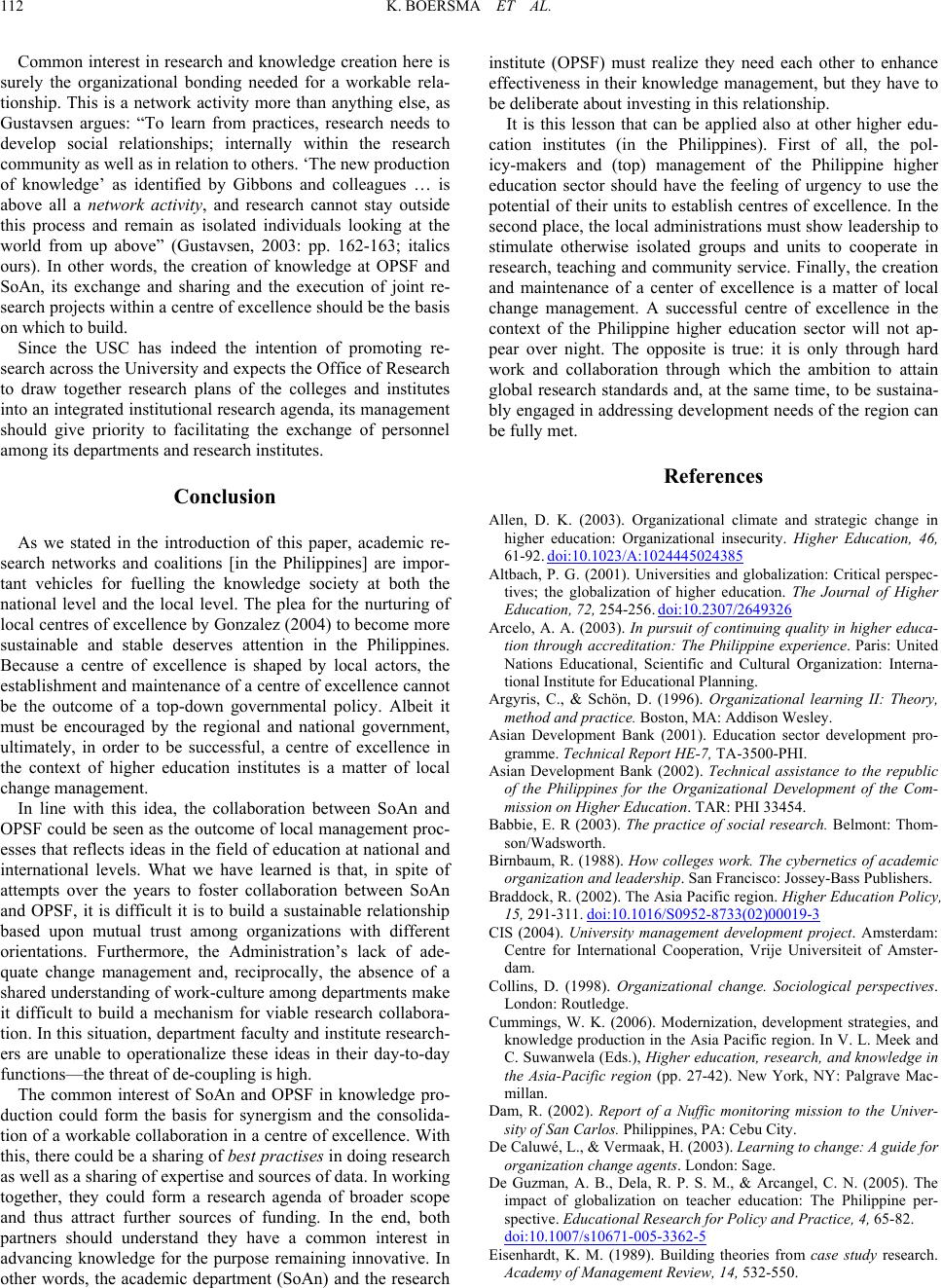 K. BOERSMA ET AL. 112 Common interest in research and knowledge creation here is surely the organizational bonding needed for a workable rela- tionship. This is a network activity more than anything else, as Gustavsen argues: “To learn from practices, research needs to develop social relationships; internally within the research community as well as in relation to others. ‘The new production of knowledge’ as identified by Gibbons and colleagues … is above all a network activity, and research cannot stay outside this process and remain as isolated individuals looking at the world from up above” (Gustavsen, 2003: pp. 162-163; italics ours). In other words, the creation of knowledge at OPSF and SoAn, its exchange and sharing and the execution of joint re- search projects within a centre of excellence should be the basis on which to build. Since the USC has indeed the intention of promoting re- search across the University and expects the Office of Research to draw together research plans of the colleges and institutes into an integrated institutional research agenda, its management should give priority to facilitating the exchange of personnel among its departments and research institutes. Conclusion As we stated in the introduction of this paper, academic re- search networks and coalitions [in the Philippines] are impor- tant vehicles for fuelling the knowledge society at both the national level and the local level. The plea for the nurturing of local centres of excellence by Gonzalez (2004) to become more sustainable and stable deserves attention in the Philippines. Because a centre of excellence is shaped by local actors, the establishment and maintenance of a centre of excellence cannot be the outcome of a top-down governmental policy. Albeit it must be encouraged by the regional and national government, ultimately, in order to be successful, a centre of excellence in the context of higher education institutes is a matter of local change management. In line with this idea, the collaboration between SoAn and OPSF could be seen as the outcome of local management proc- esses that reflects ideas in the field of education at national and international levels. What we have learned is that, in spite of attempts over the years to foster collaboration between SoAn and OPSF, it is difficult it is to build a sustainable relationship based upon mutual trust among organizations with different orientations. Furthermore, the Administration’s lack of ade- quate change management and, reciprocally, the absence of a shared understanding of work-culture among departments make it difficult to build a mechanism for viable research collabora- tion. In this situation, department faculty and institute research- ers are unable to operationalize these ideas in their day-to-day functions—the threat of de-coupling is high. The common interest of SoAn and OPSF in knowledge pro- duction could form the basis for synergism and the consolida- tion of a workable collaboration in a centre of excellence. With this, there could be a sharing of best practises in doing research as well as a sharing of expertise and sources of data. In working together, they could form a research agenda of broader scope and thus attract further sources of funding. In the end, both partners should understand they have a common interest in advancing knowledge for the purpose remaining innovative. In other words, the academic department (SoAn) and the research institute (OPSF) must realize they need each other to enhance effectiveness in their knowledge management, but they have to be deliberate about investing in this relationship. It is this lesson that can be applied also at other higher edu- cation institutes (in the Philippines). First of all, the pol- icy-makers and (top) management of the Philippine higher education sector should have the feeling of urgency to use the potential of their units to establish centres of excellence. In the second place, the local administrations must show leadership to stimulate otherwise isolated groups and units to cooperate in research, teaching and community service. Finally, the creation and maintenance of a center of excellence is a matter of local change management. A successful centre of excellence in the context of the Philippine higher education sector will not ap- pear over night. The opposite is true: it is only through hard work and collaboration through which the ambition to attain global research standards and, at the same time, to be sustaina- bly engaged in addressing development needs of the region can be fully met. References Allen, D. K. (2003). Organizational climate and strategic change in higher education: Organizational insecurity. Higher Education, 46, 61-92. doi:10.1023/A:1024445024385 Altbach, P. G. (2001). Universities and globalization: Critical perspec- tives; the globalization of higher education. The Journal of Higher Education, 72, 254-256. doi:10.2307/2649326 Arcelo, A. A. (2003). In pursuit of continuing quality in higher educa- tion through accreditation: The Philippine experience. Paris: United Nations Educational, Scientific and Cultural Organization: Interna- tional Institute for Educational Planning. Argyris, C., & Schön, D. (1996). Organizational learning II: Theory, method and practice. Boston, MA: Addison Wesley. Asian Development Bank (2001). Education sector development pro- gramme. Technical Report HE-7, TA-3500-PHI. Asian Development Bank (2002). Technical assistance to the republic of the Philippines for the Organizational Development of the Com- mission on Higher Education. TAR: PHI 33454. Babbie, E. R (2003). The practice of social research. Belmont: Thom- son/Wadsworth. Birnbaum, R. (1988). How colleges work. The cybernetics of academic organization and l eadership. San Francisco : Jossey-Bass Publishers. Braddock, R. (2002). The Asia Pacific region. Higher Education Policy, 15, 291-311. doi:10.1016/S0952-8733(02)00019-3 CIS (2004). University management development project. Amsterdam: Centre for International Cooperation, Vrije Universiteit of Amster- dam. Collins, D. (1998). Organizational change. Sociological perspectives. London: Routledge. Cummings, W. K. (2006). Modernization, development strategies, and knowledge production in the Asia Pacific region. In V. L. Meek and C. Suwanwela (Eds.), Higher education, research, and knowledge in the Asia-Pacific region (pp. 27-42). New York, NY: Palgrave Mac- millan. Dam, R. (2002). Report of a Nuffic monitoring mission to the Univer- sity of San Carlos. Philippines, PA: Cebu City. De Caluwé, L., & Vermaak, H. (2003). Learning to change: A guide for organization change ag ent s. London: Sage. De Guzman, A. B., Dela, R. P. S. M., & Arcangel, C. N. (2005). The impact of globalization on teacher education: The Philippine per- spective. Educational Resear c h for Policy and Practice, 4 , 65-82. doi:10.1007/s10671-005-3362-5 Eisenhardt, K. M. (1989). Building theories from case study research. Academy of Management Review, 14, 532-550. 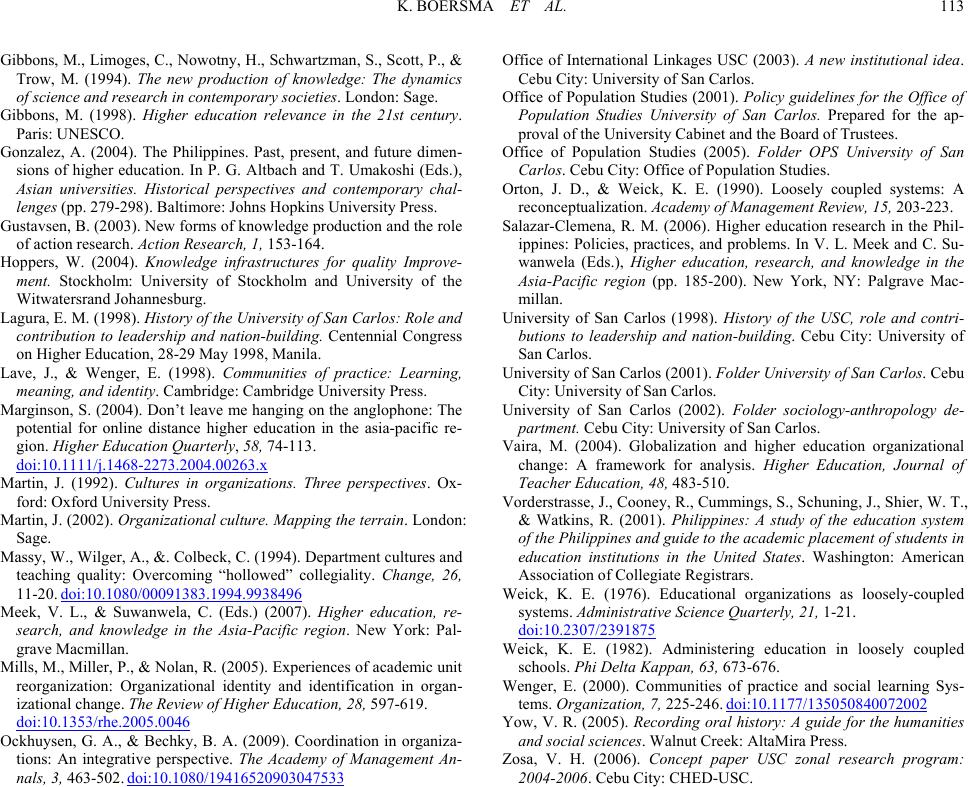 K. BOERSMA ET AL. 113 Gibbons, M., Limoges, C., Nowotny, H., Schwartzman, S., Scott, P., & Trow, M. (1994). The new production of knowledge: The dynamics of science and research in contemporary societies. London: Sa ge . Gibbons, M. (1998). Higher education relevance in the 21st century. Paris: UNESCO. Gonzalez, A. (2004). The Philippines. Past, present, and future dimen- sions of higher education. In P. G. Altbach and T. Umakoshi (Eds.), Asian universities. Historical perspectives and contemporary chal- lenges (pp. 279-298). Baltimore : Jo hn s Ho pki ns U ni ve rsity Press. Gustavsen, B. (2003). New forms of knowledge production and the role of action research. Action Research, 1, 153-164. Hoppers, W. (2004). Knowledge infrastructures for quality Improve- ment. Stockholm: University of Stockholm and University of the Witwatersrand Johannes bu rg. Lagura, E. M. (1998). History of the University of San C ar lo s: Role and contribution to leadership and nation-building. Centennial Congress on Higher Education, 28-29 May 1998, Manila. Lave, J., & Wenger, E. (1998). Communities of practice: Learning, meaning, and identity. Cambridge: Cambr idge University Press. Marginson, S. (2004). Don’t leave me hanging on the anglophone: The potential for online distance higher education in the asia-pacific re- gion. Higher Educa t ion Quarterly, 58, 74-113. doi:10.1111/j.1468-2273.2004.00263.x Martin, J. (1992). Cultures in organizations. Three perspectives. Ox- ford: Oxford University Press. Martin, J. (2002). Organizational culture. Mapping the terrain. London: Sage. Massy, W., Wilger, A., &. Colbeck, C. (1994). Department cultures and teaching quality: Overcoming “hollowed” collegiality. Change, 26, 11-20. doi:10.1080/00091383.1994.9938496 Meek, V. L., & Suwanwela, C. (Eds.) (2007). Higher education, re- search, and knowledge in the Asia-Pacific region. New York: Pal- grave Macmillan. Mills, M., Miller, P., & Nolan, R. (2005). Experiences of academic unit reorganization: Organizational identity and identification in organ- izational change. The Review of Higher Education, 28, 597-619. doi:10.1353/rhe.2005.0046 Ockhuysen, G. A., & Bechky, B. A. (2009). Coordination in organiza- tions: An integrative perspective. The Academy of Management An- nals, 3, 463-502. doi:10.1080/19416520903047533 Office of International Linkages USC (2003). A new institutional idea. Cebu City: University of San Carlos. Office of Population Studies (2001). Policy guidelines for the Office of Population Studies University of San Carlos. Prepared for the ap- proval of the Univ ersity Cabinet and the Board of Trustees. Office of Population Studies (2005). Folder OPS University of San Carlos. Cebu City: Off i ce of Population Studi e s. Orton, J. D., & Weick, K. E. (1990). Loosely coupled systems: A reconceptualization. Academy of Management Review, 15, 203-223. Salazar-Clemena, R. M. (2006). Higher education research in the Phil- ippines: Policies, practices, and problems. In V. L. Meek and C. Su- wanwela (Eds.), Higher education, research, and knowledge in the Asia-Pacific region (pp. 185-200). New York, NY: Palgrave Mac- millan. University of San Carlos (1998). History of the USC, role and contri- butions to leadership and nation-building. Cebu City: University of San Carlos. University of San Carlos (2001). Folder University of San Carlos. Cebu City: University of San Carlos. University of San Carlos (2002). Folder sociology-anthropology de- partment. Cebu City : U ni ve rsity of San Carlos. Vaira, M. (2004). Globalization and higher education organizational change: A framework for analysis. Higher Education, Journal of Teacher Education, 4 8 , 483-510. Vorderstrasse, J., Cooney, R., Cummings, S., Schuning, J., Shier, W. T., & Watkins, R. (2001). Philippines: A study of the education system of the Philippines and guide to the academic placement of students in education institutions in the United States. Washington: American Association of Coll egiate Registrars. Weick, K. E. (1976). Educational organizations as loosely-coupled systems. Administrative Science Quarterly, 21, 1-21. doi:10.2307/2391875 Weick, K. E. (1982). Administering education in loosely coupled schools. Phi Delta Kappan, 63, 673-676. Wenger, E. (2000). Communities of practice and social learning Sys- tems. Organization, 7, 225-246. doi:10.1177/135050840072002 Yow, V. R. (2005). Recording oral history: A guide for the humanities and social sciences. Walnut Creek: AltaMira Press. Zosa, V. H. (2006). Concept paper USC zonal research program: 2004-2006. Cebu City: CHED-USC.
|